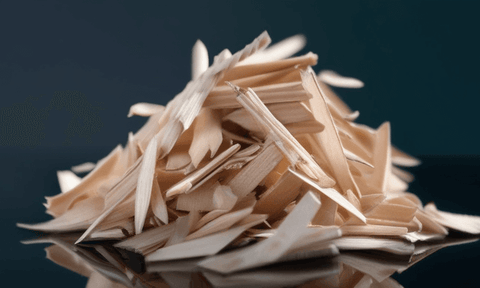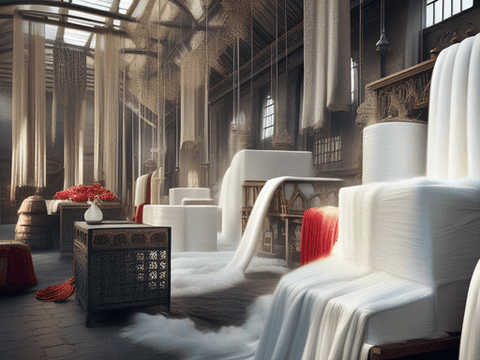
Viscose: everything you need to know about this fiber
Share
In the world of fashion and textiles, viscose occupies a special place thanks to its great versatility. In this comprehensive guide, let's embark together on a journey through the various dimensions of this fiber. Let's discover its origins, its unique properties, as well as the advantages and disadvantages associated with it.

What is viscose?
Viscose is a somewhat special textile fiber, positioned halfway between natural and synthetic fibers . Essentially, it is classified as a man-made fiber , meaning that it is derived from a natural material , in this case wood pulp , and transformed through a chemical process.
This fiber gets its name from the manufacturing process to which it is subjected. The term "viscose" is related to the viscosity of the solution obtained during the chemical transformation . The wood pulp undergoes a series of treatments including dissolution, filtration, and regeneration to give rise to the viscose fiber.
Why is viscose so widely used in the textile industry? Its qualities make it a very popular option. First of all, viscose offers a softness comparable to that of natural fibers such as cotton , making it pleasant to the touch and comfortable to wear. In addition, it has an excellent absorbency , allowing the skin to breathe and thus providing optimal comfort, especially in hot climates.
Viscose also stands out for its versatility . It can mimic the look and feel of natural fibers such as silk, linen, or wool , while being more affordable. This makes it an attractive option for manufacturers looking to offer aesthetic alternatives without compromising cost.
In addition, it exhibits exceptional dyeing properties, allowing for an almost infinite range of vibrant colors.

The history of viscose
Let's go back to the 19th century to discover the origin of viscose, the first artificial fiber that would revolutionize the textile industry. The year 1884 marked a decisive turning point with the invention of viscose by Count Hilaire de Chardonnet , a French inventor driven by the search for an alternative to silk.
Count Chardonnet, faced with the challenges of scarcity and high cost of natural silk, undertook a new quest. His goal was to reproduce the luxurious qualities of silk in a more accessible way . The result of his efforts was the creation of viscose, hence nicknamed " artificial silk ".
The uniqueness of viscose lies in its manufacturing process. Chardonnet managed to extract cellulose from wood fibers to create a substance reminiscent of natural silk. This new fiber offered an affordable alternative while retaining the characteristic luster and softness of its natural counterpart .
From its beginnings, viscose aroused the enthusiasm of fashion designers. Its great versatility allowed the exploration of new artistic possibilities, opening the way to new textile creations.
Although it originated in France, viscose was patented by Cross, Bevan and Beadle in the United Kingdom in 1892, before gaining worldwide recognition at the beginning of the following century, when the inventors succeeded in producing it in quantity. Viscose then quickly transcended borders to become a global resource . Today, its production and use are widespread internationally, highlighting its major role in the textile industry.

The viscose manufacturing process
Viscose is produced from cellulose found in wood, often beech, pine or eucalyptus . The process begins by dissolving the wood pulp in an alkaline solution, forming a pulp that is then chemically treated to obtain viscose. This substance is then spun to create fibers that are used in the manufacture of textiles.
Environmental Impact
However, viscose production is unfortunately not without environmental concerns . In many developing countries, viscose production is associated with water pollution problems and intense consumption of natural resources . The chemical processes used can have negative impacts on local ecosystems.
It is important to note, however, that the industry is changing. Faced with increasing pressure to adopt sustainable practices, many viscose manufacturers are making notable efforts to minimise their environmental footprint . Some are choosing more sustainable sources of cellulose, such as bamboo or eucalyptus pulp, from responsibly managed forests. These products often carry PEFC-FSC or FSC certificates, guaranteeing an environmentally friendly origin. At the same time, the manufacturing processes themselves are becoming more refined .
Among these initiatives, sustainable alternatives from the Lyocell process stand out. Modal, Eco Vero and Tencel are examples of viscose produced using this process . Modal is made from beech wood cellulose, while Eco Vero is woven from sustainable European wood cellulose. Additionally, Tencel is made from eucalyptus cellulose . These alternatives require less water than traditional viscose and are known for their strength and ease of care. In addition, the Lyocell process uses a non-toxic and recyclable solvent , which helps reduce the environmental impact of viscose production.
Contribute to an Anti-Waste approach
As a savvy consumer, choosing our end-of-line viscose fabrics is a pragmatic decision in favor of sustainability. Indeed, by opting for our products, you are actively participating in reducing waste . Explore our unique viscose collection now, where each purchase contributes to minimizing our environmental footprint . We are sure that you will find what you are looking for.

The Advantages of Viscose
- Fluidity and elegant drape : Viscose offers superb fluidity, giving garments a natural elegance. Drapes and folds are enhanced, creating even more flattering silhouettes.
- Comfort and softness : Appreciated for its softness, viscose is pleasant to wear. It provides a feeling of comfort, which makes it an ideal choice for everyday clothing.
- Breathability : The breathable nature of viscose makes it a popular summer option. It allows air to circulate, ensuring a cool feeling even in hot weather.
- Moisture Absorption : As mentioned at the beginning of the article, viscose absorbs moisture efficiently, helping to keep our precious skin dry. One more quality that makes it a wise choice for hot summer days.
Disadvantages of viscose
- Water sensitivity : Viscose has the particularity of being sensitive to water. Its maintenance requires special attention, with precautions such as hand washing and flat drying.
- Wrinkling : Although viscose is elegant, it tends to wrinkle more easily than other fabrics. Ironing may be necessary to maintain the neat appearance of your creations.
- Wear and tear over time : Viscose can show signs of wear and tear more quickly than other fabrics, especially if subjected to heavy use. Regular care is therefore essential to prolong its durability.
We have now reached the conclusion of our article on viscose . We hope you enjoyed it and we look forward to seeing you soon for more exciting articles!
